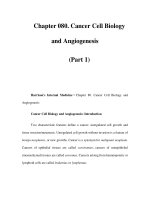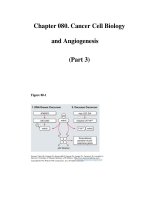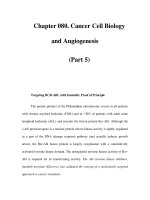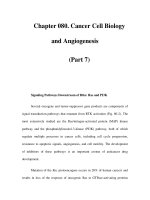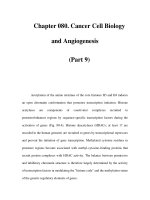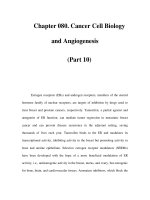Ebook Plant biology and biotechnology (Volume II: Plant genomics and biotechnology): Part 1
Bạn đang xem bản rút gọn của tài liệu. Xem và tải ngay bản đầy đủ của tài liệu tại đây (9.76 MB, 405 trang )
Bir Bahadur · Manchikatla Venkat Rajam
Leela Sahijram · K.V. Krishnamurthy
Editors
Plant Biology
and Biotechnology
Volume II: Plant Genomics and Biotechnology
Plant Biology and Biotechnology
Bir Bahadur • Manchikatla Venkat Rajam
Leela Sahijram • K.V. Krishnamurthy
Editors
Plant Biology and
Biotechnology
Volume II: Plant Genomics
and Biotechnology
Editors
Bir Bahadur
Sri Biotech Laboratories India Limited
Hyderabad, Telangana, India
Leela Sahijram
Division of Biotechnology
Indian Institute of Horticultural
Research (IIHR)
Bangalore, Karnataka, India
Manchikatla Venkat Rajam
Department of Genetics
University of Delhi
New Delhi, India
K.V. Krishnamurthy
Center for Pharmaceutics,
Pharmacognosy and Pharmacology,
School of Life Sciences
Institute of Trans-Disciplinary Health
Science and Technology (IHST)
Bangalore, Karnataka, India
ISBN 978-81-322-2282-8
ISBN 978-81-322-2283-5
DOI 10.1007/978-81-322-2283-5
(eBook)
Library of Congress Control Number: 2015941731
Springer New Delhi Heidelberg New York Dordrecht London
© Springer India 2015
This work is subject to copyright. All rights are reserved by the Publisher, whether the whole or
part of the material is concerned, specifically the rights of translation, reprinting, reuse of
illustrations, recitation, broadcasting, reproduction on microfilms or in any other physical way,
and transmission or information storage and retrieval, electronic adaptation, computer software,
or by similar or dissimilar methodology now known or hereafter developed.
The use of general descriptive names, registered names, trademarks, service marks, etc. in this
publication does not imply, even in the absence of a specific statement, that such names are
exempt from the relevant protective laws and regulations and therefore free for general use.
The publisher, the authors and the editors are safe to assume that the advice and information in
this book are believed to be true and accurate at the date of publication. Neither the publisher nor
the authors or the editors give a warranty, express or implied, with respect to the material
contained herein or for any errors or omissions that may have been made.
Printed on acid-free paper
Springer (India) Pvt. Ltd. is part of Springer Science+Business Media (www.springer.com)
Foreword
While writing this Foreword, I was reminded of a quote attributed to Mahatma
Gandhi: “The expert knows more and more about less and less until he knows
everything about nothing.” The quote illustrates the great dilemma that all of
us face in modern times: but this is especially acute for those engaged in the
pursuit of science. Compared to the times of Archimedes or Leonardo da
Vinci or Antonie Philips van Leeuwenhoek, whose range of interests covered
several disciplines (they looked at the world in its entirety), most of us have
now become narrow specialists of one kind or another, knowing less and less
about the wider world. Thus, edited monographs, proceedings of seminars
and the like have become absolutely essential to keep us informed and
engaged in research and teaching more meaningfully (such publications
allow summarizing of recent researches at a more advanced level than is possible in ordinary textbooks).
Turning to plant sciences, the Annual Review of Plant Biology, started in
the middle of the last century, continues to be an invaluable source of information on the broad advances of plant biology. Yet, it is necessary to have a
more inclusive look at advances over a somewhat longer period and also have
this information in a way more organized than the format of annual reviews
allows. Thus, Prof. Bir Bahadur and his colleagues deserve our grateful
thanks on undertaking an incredibly difficult task of summarizing advances
on the very broad front of plant biology – the topics cover not only fundamental aspects of plant biology but also plant biotechnology, which is now growing almost as a separate discipline. I welcome their style of a historical
approach (nearly every article follows this style). This approach is often
neglected by specialists, but the fact is that this is the only way to genuine
understanding and for a non-expert to easily discern major advances or milestones. This unity in overall planning and laying out the style has obviously
been possible due to the fact that two of three co-editors are in fact former
pupils of the senior editor (Prof. Rajam, the senior most of them, was, in a
sense, a colleague while I was at Delhi University). Understandably, in the
combined work on Volumes I and II, Prof. Bir Bahadur is author of nearly ten
chapters and Prof. Rajam author of five chapters. Their two other colleagues
Dr. Leela Sahijram and Prof. Krishnamurthy have also contributed several
chapters. Nonetheless, the work has very valuable contributions also from
several national and international contributors (in Volume 2, there are around
v
Foreword
vi
ten authors from outside India), which has immensely added to the value of
this work.
I think that on the whole, a very laudable contribution has been made. The
editors have managed to include almost all topics which are significant in
modern plant biology. In Volume 1, I was delighted to see several chapters
close to my interest, such as those relating to polyploidy, photosynthesis,
apomixis and flower development. But in Volume 2, there is special emphasis
on genomics and plant biotechnology, and there are many other chapters of
current interest. Space is not adequate to mention all the chapters or their topics, but to me, those on genetic markers, doubled haploids, plant genomes and
genomics (there are several on these topics), epigenetic mechanisms, bioinformatics and systems biology were of special interest. Also, I am very
delighted that Volume 2 starts with an excellent chapter on Arabidopsis thaliana. Inspired by a lecture on Langridge’s work by Prof. Arthur W. Galston, I
undertook in 1960s to ‘tame’ a wild Indian strain of Arabidopsis by raising
in vitro cultures. However, despite the fact that Arabidopsis is now the principal material for basic research in plant biology, there are many who have
never seen a live Arabidopsis plant, and surely, the opening chapter of this
volume will be valuable for all.
Although ably aided by his pupils, Prof. Bahadur remains the chief architect of this endeavour. And I am struck with the expanse of his canvas and the
breadth of his interest – it seems to me that in part, it is due to his early association with Prof. J.B.S. Haldane, F.R.S., whose own interest covered many
disciplines, from mathematics, biochemistry and genetics to animal and plant
biology. The topics he and his colleagues cover are of both fundamental and
applied interest. I have to admit that many of us in universities are a bit distant
from fields and sometimes unfamiliar with the full potential of fundamental
discoveries for biotechnological applications. This work will help focus due
attention of readers on both aspects of plant biology.
When the chapters were first sent to me, I noticed many typographic mistakes than are normally present in finished manuscripts – it is true that English is not the mother tongue of many of us in India, but I hope these mistakes
have been rectified.
Once again, I wish to congratulate Prof. Bir Bahadur and his colleagues
for a very unique monograph and insight in modern plant biology.
Honorary Scientist of the Indian, National
Science Academy, Biotechnology Laboratories
Centre for Converging Technologies
University of Rajasthan, Jaipur, India
Satish C. Maheshwari
Preface
The human population is increasing at an alarming rate and is expected to
reach 11 billion by 2050. As there is a big gap between population growth
and food production, food security for an ever-increasing population poses a
major challenge for the present and future times. In fact, it will become necessary in the coming two decades or so to double food production with available arable land; else, it may precipitate great famines in some parts of the
world. This is not achievable with just conventional strategies like plant
breeding. However, the projected increase in food production may be achieved
if traditional breeding methods are coupled with biotechnological approaches
as the latter can offer novel ways for increasing productivity and quality of
crops as also for producing an array of useful compounds including pharmaceuticals and biofuels. Indeed, during the past couple of decades, dramatic
progress has been made in the field of plant genomics and biotechnology.
Therefore, a need was felt for updating scientific developments in these areas.
Plant Biology and Biotechnology – Volume 2 was planned to present stateof-the-art scientific information on various basic and applied aspects of plant
genomics. This volume comprises 37 chapters spanning various aspects of
plant genomics and biotechnology and provides comprehensive and updated
information on a wide variety of topics including Arabidopsis as a wonderful
model system for plant research, plant–fungus interactions, microalgae in
biotechnological applications, genetic markers and marker-assisted breeding,
doubled haploids in breeding, DNA fingerprinting for plant identification,
nuclear and organellar genomes, functional genomics, proteomics, epigenomics, bioinformatics, systems biology, applications of tissue culture in
crop improvement and conservation of plant genetic resources, genetically
modified crops for production of commercially important products and engineering abiotic and biotic stress tolerance, RNAi and microRNAs in crop
improvement and environmental, marine, desert and rural biotechnologies.
The book can serve as a good reference for plant molecular geneticists, plant
biotechnologists, plant breeders, agricultural scientists and food scientists.
Besides, it will also serve as a reference book for post-graduate students,
researchers and teachers besides scientists working in agri-biotech
companies.
Contributors of these volumes were selected from a wide range of institutions for introducing a diversity of authors. At the same time, these authors
were selected based on their vast expertise in specific areas of their choice to
vii
Preface
viii
match the diversity of topics. These authors have a deep understanding of
their subject to enable them not only to write critical reviews by integrating
information from classical to modern literature but also to endure an unending series of editorial suggestions and revisions of their manuscripts. Needless to say, this is as much their book as ours.
We hope that these books will help our fellow teachers and a generation of
students enter the fascinating world of plant genomics and biotechnology
with confidence, as perceived and planned by us.
Hyderabad, Telangana, India
New Delhi, India
Bangalore, Karnataka, India
Bangalore, Karnataka, India
Bir Bahadur
Manchikatla Venkat Rajam
Leela Sahijram
K.V. Krishnamurthy
Acknowledgements
First and foremost, we are immensely grateful to all the contributing authors
for their positive response. We are most grateful to Prof. S.C. Maheshwari for
kindly agreeing to write the Foreword for this volume.
We wish to express our grateful thanks to a number of friends and colleagues for their invaluable help in many ways and for their suggestions from
time to time during the evolution of the two volumes. We also thank research
scholars of Prof. M.V. Rajam (University of Delhi South Campus) – Shipra
Saxena, Meenakshi Tetorya, Mahak Sachdeva, Bhawna Israni, Mamta,
Manish Pareek, Anjali Jaiswal, Jyotsna Naik, Sneha Yogindran and Ami
Choubey for their help in many ways.
We wish to express our appreciation for the help rendered by Ms. Surabhi
Shukla, Ms. Raman, Mr.N.S. Pandian and other staff of Springer for their
cooperation and invaluable suggestions. Above all, their professionalism,
which made these books a reality, is greatly appreciated.
We wish to express our grateful thanks to our respective family members
for their cooperation.
Editors
Bir Bahadur
Manchikatla Venkat Rajam
Leela Sahijram
K.V. Krishnamurthy
ix
Contents
1
Arabidopsis thaliana: A Model for Plant Research ....................
R. Sivasubramanian, Nitika Mukhi, and Jagreet Kaur
2
Microalgae in Biotechnological Application:
A Commercial Approach ..............................................................
Nilofer Khatoon and Ruma Pal
27
Application of Biotechnology and Bioinformatics Tools
in Plant–Fungus Interactions .......................................................
Mugdha Srivastava, Neha Malviya, and Thomas Dandekar
49
3
4
5
Genetic Markers, Trait Mapping and Marker-Assisted
Selection in Plant Breeding ..........................................................
P. Kadirvel, S. Senthilvel, S. Geethanjali, M. Sujatha,
and K.S. Varaprasad
Doubled Haploid Platform: An Accelerated Breeding
Approach for Crop Improvement................................................
Salej Sood and Samresh Dwivedi
1
65
89
6
Plant Molecular Biology Applications in Horticulture:
An Overview .................................................................................. 113
Kanupriya Chaturvedi and Leela Sahijram
7
A History of Genomic Structures: The Big Picture ................... 131
Nicolas Carels
8
Organellar Genomes of Flowering Plants................................... 179
Ami Choubey and Manchikatla Venkat Rajam
9
DNA Fingerprinting Techniques for Plant Identification ......... 205
J.L. Karihaloo
10
Functional Genomics .................................................................... 223
Leonardo Henrique Ferreira Gomes,
Marcelo Alves-Ferreira, and Nicolas Carels
11
Translating the Genome for Translational Research:
Proteomics in Agriculture ............................................................ 247
Maria Elena T. Caguioa, Manish L. Raorane, and Ajay Kohli
xi
Contents
xii
12
Epigenetic Mechanisms in Plants: An Overview........................ 265
Anjana Munshi, Y.R. Ahuja, and Bir Bahadur
13
Bioinformatics: Application to Genomics ................................... 279
S. Parthasarathy
14
Systems Biology: A New Frontier in Science .............................. 301
S.R. Sagurthi, Aravind Setti, and Smita C. Pawar
15
Somatic Embryogenesis ................................................................ 315
Leela Sahijram and Bir Bahadur
16
Micropropagation of Plants ......................................................... 329
Aneesha Singh
17
Efficacy of Biotechnological Approaches to Raise
Wide Sexual Hybrids .................................................................... 347
K.R. Shivanna and Bir Bahadur
18
Hybrid Embryo Rescue in Crop Improvement .......................... 363
Leela Sahijram and B. Madhusudhana Rao
19
Applications of Triploids in Agriculture ..................................... 385
Ashwani Kumar and Nidhi Gupta
20
Improving Secondary Metabolite Production
in Tissue Cultures .......................................................................... 397
Ashwani Kumar
21
Somaclonal Variation in Micropropagated Plants ..................... 407
Leela Sahijram
22
In Vitro Conservation of Plant Germplasm................................ 417
P.E. Rajasekharan and Leela Sahijram
23
Gene Banking for Ex Situ Conservation
of Plant Genetic Resources ........................................................... 445
P.E. Rajasekharan
24
Conservation and Management of Endemic
and Threatened Plant Species in India: An Overview ............... 461
Radhamani Jalli, J. Aravind, and Anjula Pandey
25
Biotechnological Approaches in Improvement
of Spices: A Review ....................................................................... 487
K. Nirmal Babu, Minoo Divakaran, Rahul P. Raj,
K. Anupama, K.V. Peter, and Y.R. Sarma
26
Metabolic Engineering in Plants.................................................. 517
Ashwani Kumar
27
Genetically Modified Crops ......................................................... 527
S.B. Nandeshwar
Contents
xiii
28
Engineering of Plants for the Production
of Commercially Important Products:
Approaches and Accomplishments .............................................. 551
Salah E. Abdel-Ghany, Maxim Golovkin, and A.S.N. Reddy
29
Genetic Engineering Strategies for Abiotic Stress
Tolerance in Plants ........................................................................ 579
Francisco Marco, Marta Bitrián, Pedro Carrasco,
Manchikatla Venkat Rajam, Rubén Alcázar,
and Antonio F. Tiburcio
30
Genetic Engineering Strategies for Biotic Stress
Tolerance in Plants ........................................................................ 611
K. Sowjanya Sree and Manchikatla Venkat Rajam
31
RNAi for Crop Improvement ....................................................... 623
Sneha Yogindran and Manchikatla Venkat Rajam
32
Plant MicroRNAs: Biogenesis, Functions,
and Applications ............................................................................ 639
Manish Pareek, Sneha Yogindran, S.K. Mukherjee,
and Manchikatla Venkat Rajam
33
Environmental Biotechnology: A Quest for Sustainable
Solutions ......................................................................................... 663
Sneha V. Nanekar and Asha A. Juwarkar
34
Phytoremediation: General Account and Its Application ......... 673
Jitendra K. Sharma and Asha A. Juwarkar
35
Marine Biotechnology: Potentials of Marine Microbes
and Algae with Reference to Pharmacological
and Commercial Values ................................................................ 685
M. Nagarajan, R. Rajesh Kumar, K. Meenakshi Sundaram,
and M. Sundararaman
36
Desert Plant Biotechnology: Jojoba, Date Palm,
and Acacia Species ........................................................................ 725
Muppala P. Reddy
37
Rural Biotechnology in Transforming Agriculture
and Rural Livelihood .................................................................... 743
Lekha Bandopadhyay and Samir Ranjan Sikdar
Index ....................................................................................................... 755
Contributors
Salah E. Abdel-Ghany Department of Biology, Program in Molecular Plant
Biology, Program in Cell and Molecular Biology, Colorado State University,
Fort Collins, CO, USA
Faculty of Science, Botany Department, Zagazig University, Zagazig, Egypt
Y.R. Ahuja Department of Molecular Medicine, Vasavi Hospital and
Research Centre, Hyderabad, Telangana, India
Rubén Alcázar Unitat de Fisiologia Vegetal, Facultat de Farmàcia,
Universitat de Barcelona, Barcelona, Spain
Marcelo Alves-Ferreira Laboratório de Modelagem de Sistemas
Biológicos, National Institute for Science and Technology on Innovation in
Neglected Diseases (INCT/IDN), Centro de Desenvolvimento Tecnolúgico
em Saỳde (CDTS), Fundaỗóo Oswaldo Cruz (FIOCRUZ), Rio de Janeiro,
Brazil
K. Anupama Division of Crop Improvement and Biotechnology, Indian
Institute of Spices Research, Kozhikode, Kerala, India
J. Aravind Division of Germplasm Conservation, ICAR-National Bureau of
Plant Genetic Resources, New Delhi, India
Bir Bahadur Sri Biotech Laboratories India Limited, Hyderabad, Telangana,
India
Lekha Bandopadhyay Bose Institute, Kolkata, West Bengal, India
Marta Bitrián Department of Molecular Mechanisms of Phenotypic
Plasticity, Institut de Biologie Moléculaire des Plantes, Centre National de la
Recherche Scientifique, Strasbourg, France
Maria Elena T. Caguioa Plant Molecular Biology Laboratory, International
Rice Research Institute (IRRI), Metro Manila, Philippines
Nicolas Carels Laboratório de Modelagem de Sistemas Biológicos, National
Institute for Science and Technology on Innovation in Neglected Diseases
(INCT/IDN), Centro de Desenvolvimento Tecnolúgico em Saỳde (CDTS),
Fundaỗóo Oswaldo Cruz (FIOCRUZ), Rio de Janeiro, Brazil
xv
xvi
Pedro Carrasco Departament de Bioquímica i Biologia Molecular, Facultat
de Ciències Biològiques, Universitat de València, València, Burjassot, Spain
Kanupriya Chaturvedi Division of Biotechnology, Indian Institute of
Horticultural Research (IIHR), Bangalore, Karnataka, India
Ami Choubey Department of Genetics, University of Delhi South Campus,
New Delhi, India
Thomas Dandekar Functional Genomics and Systems Biology group,
Department of Bioinformatics, Biocenter, Wuerzburg, Germany
Minoo Divakaran Indian Institute of Spices Research, Kozhikode, Kerala,
India
Department of Botany, Providence Women’s College, Kozhikode, Kerala,
India
Samresh Dwivedi Crop Development-Agri-Business Division, ITC Life
Sciences Technology Centre, ITC-ABD, Secunderabad, Telangana, India
S. Geethanjali Centre for Plant Breeding and Genetics, Tamil Nadu
Agricultural University, Coimbatore, Tamil Nadu, India
Maxim Golovkin Foundation for Advancement of Science, Technology and
Research, PA Biotechnology Center, Doylestown, PA, USA
Leonardo Henrique Ferreira Gomes Laboratúrio de Genụmica Funcional
e Bioinformỏtica, Instituto Oswaldo Cruz (IOC) Fundaỗóo Oswaldo Cruz
(FIOCRUZ), Rio de Janeiro, Brazil
Nidhi Gupta Department of Biotechnology, C.C.S. University, Meerut,
Uttar Pradesh, India
Radhamani Jalli Division of Germplasm Conservation, ICAR-National
Bureau of Plant Genetic Resources, New Delhi, India
Asha A. Juwarkar Eco-System Division, CSIR-National Environmental
Engineering Research Institute (CSIR-NEERI), Nagpur, Maharashtra, India
P. Kadirvel Directorate of Oilseeds Research, Indian Council of Agricultural
Research, Hyderabad, Telangana, India
J.L. Karihaloo Asia-Pacific Association of Agricultural Research Institutions,
National Agricultural Science Complex, New Delhi, India
Jagreet Kaur Department of Genetics, University of Delhi South Campus,
New Delhi, India
Nilofer Khatoon Department of Botany, University of Calcutta, Kolkata,
West Bengal, India
Ajay Kohli Plant Molecular Biology Laboratory, International Rice
Research Institute (IRRI), Metro Manila, Philippines
Ashwani Kumar Department of Botany, University of Rajasthan, Jaipur,
Rajasthan, India
Contributors
Contributors
xvii
B. Madhusudhana Rao Division of Biotechnology, Indian Institute of
Horticultural Research (IIHR), Bangalore, Karnataka, India
Neha Malviya Department of Biotechnology, Deen Dayal Upadhyay
Gorakhpur University, Gorakhpur, UP, India
Francisco Marco Departament de Biologia Vegetal, Facultat de Farmàcia,
Universitat de València, València, Burjassot, Spain
K. Meenakshi Sundaram Department of Marine Biotechonology, School
of Marine Sciences, Bharathidasan University, Tiruchirappalli, Tamil Nadu,
India
S.K. Mukherjee Department of Genetics, University of Delhi South
Campus, New Delhi, India
Nitika Mukhi Department of Genetics, University of Delhi South Campus,
New Delhi, India
Anjana Munshi Centre for Human Genetics, School of Health Sciences,
Central University of Punjab, Bathinda, Punjab, India
M. Nagarajan Department of Marine Biotechonology, School of Marine
Sciences, Bharathidasan University, Tiruchirappalli, Tamil Nadu, India
S.B. Nandeshwar Biotechnology Section, Central Institute of Cotton
Research (CICR), Nagpur, Maharashtra, India
Sneha V. Nanekar Eco-System Division, CSIR-National Environmental
Engineering Research Institute (CSIR-NEERI), Nagpur, Maharashtra, India
K. Nirmal Babu Project Coordinator, All India Coordinated Research
Project On Spices (ICAR), Indian Institute of Spices Research, Kozhikode,
Kerala, India
Ruma Pal Department of Botany, University of Calcutta, Kolkata, West
Bengal, India
Anjula Pandey Division of Plant Exploration and Germplasm Collection,
ICAR-National Bureau of Plant Genetic Resources, New Delhi, India
Manish Pareek Department of Genetics, University of Delhi South Campus,
New Delhi, India
S. Parthasarathy Department of Bioinformatics, School of Life Sciences,
Bharathidasan University, Tiruchirappalli, Tamil Nadu, India
Smita C. Pawar Department of Genetics, Osmania University, Hyderabad,
Telangana, India
K.V. Peter Former Director, Indian Institute of Spices Research, Kozhikode,
Kerala, India
Rahul P. Raj Division of Crop Improvement and Biotechnology,
Indian Institute of Spices Research, Kozhikode, Kerala, India
xviii
Manchikatla Venkat Rajam Department of Genetics, University of Delhi
South Campus, New Delhi, India
P.E. Rajasekharan Division of Plant Genetic Resources, Indian institute of
Horticultural Research (IIHR), Bangalore, Karnataka, India
R. Rajesh Kumar Department of Marine Biotechonology, School of Marine
Sciences, Bharathidasan University, Tiruchirappalli, Tamil Nadu, India
Manish L. Raorane Plant Molecular Biology Laboratory, International
Rice Research Institute (IRRI), Metro Manila, Philippines
Muppala P. Reddy Center for Desert Agriculture, 4700 King Abdullah
University of Science and Technology, Thuwal, Kingdom of Saudi Arabia
A.S.N. Reddy Department of Biology, Program in Molecular Plant Biology,
Program in Cell and Molecular Biology, Colorado State University, Fort
Collins, CO, USA
S.R. Sagurthi Department of Genetics, Osmania University, Hyderabad,
Telangana, India
Leela Sahijram Division of Biotechnology, Indian Institute of Horticultural
Research (IIHR), Bangalore, Karnataka, India
Y.R. Sarma Former Director, Indian Institute of Spices Research, Kozhikode,
Kerala, India
S. Senthilvel Directorate of Oilseeds Research, Indian Council of
Agricultural Research, Hyderabad, Telangana, India
Aravind Setti Department of Genetics, Osmania University, Hyderabad,
Telangana, India
Jitendra K. Sharma Eco-System Division, CSIR-National Environmental
Engineering Research Institute (CSIR-NEERI), Nagpur, Maharashtra, India
K.R. Shivanna Conservation Biology, Ashoka Trust for Research in Ecology
and the Environment, Royal Enclave, Bengaluru, Karnataka, India
Samir Ranjan Sikdar Bose Institute, Kolkata, West Bengal, India
Aneesha Singh Discipline of Wasteland Research, CSIR-Central Salt and
Marine Chemicals Research Institute (CSIR-CSMCRI), Bhavnagar, Gujarat,
India
R. Sivasubramanian Department of Genetics, University of Delhi South
Campus, New Delhi, India
Salej Sood Scientist, Crop Improvement Division, ICAR-Vivekananda
Institute of Hill Agriculture, Almora, Uttarakhand, India
K. Sowjanya Sree Amity Institute of Microbial Technology, Amity
University, Noida, India
Mugdha Srivastava Functional Genomics and Systems Biology group,
Department of Bioinformatics, Biocenter, Wuerzburg, Germany
Contributors
Contributors
xix
M. Sujatha Directorate of Oilseeds Research, Indian Council of Agricultural
Research, Hyderabad, Telangana, India
M. Sundararaman Department of Marine Biotechonology, School of
Marine Sciences, Bharathidasan University, Tiruchirappalli, Tamil Nadu,
India
Antonio F. Tiburcio Unitat de Fisiologia Vegetal, Facultat de Farmàcia,
Universitat de Barcelona, Barcelona, Spain
K.S. Varaprasad Directorate of Oilseeds Research, Indian Council of
Agricultural Research, Hyderabad, Telangana, India
Sneha Yogindran Department of Genetics, University of Delhi South
Campus, New Delhi, India
About the Editors
Prof. Bir Bahadur
FLS, C Biol, FI Biol (London)
Dr. Bir Bahadur, born 5 April 1938, studied at City College, Hyderabad, for
5 years including an Intermediate Course (Osmania University), graduated
from Nizam College and postgraduated from University College, Osmania
University, both in the first division. He obtained his Ph.D. in Plant Genetics
from Osmania University. He was closely associated with late Prof.
J.B.S. Haldane, F.R.S., a renowned British geneticist who encouraged him to
study heterostyly and incompatibility in Indian plants, a subject first studied
by Charles Darwin.
He made significant contributions in several areas, especially heterostyly,
incompatibility, plant genetics, mutagenesis, plant tissue culture and biotechnology, morphogenesis, application of SEM in botanical research, plant
asymmetry, plant morphology and anatomy and lately the biofuel plants Jatropha and castor.
He served as Lecturer and Reader at Osmania University, Hyderabad, and
as Reader and Professor at Kakatiya University, Warangal. He also served as
Head of Department; Chairman, Board of Studies; Dean, Faculty of Science;
and Coordinating Officer/Dean, UGC Affairs at Kakatiya University. He has
over 40 years of teaching and over 50 years of research experience. He has
supervised 29 Ph.D. students and 3 M.Phil. students in both these universities
and has published about 250 research papers/reviews, which are well received
and cited in national and international journals, textbooks and reference books.
xxi
xxii
He was a postdoctoral fellow at the Institute of Genetics, Hungarian Academy of Sciences, Budapest, and worked on mutagenesis and chromosome
replication in Rhizobium. He is a recipient of the direct award from the Royal
Society Bursar, London. He also worked at Birmingham University (UK). He
was conferred with the title of Honorary Research Fellow by the Birmingham
University. He studied species differentiation in wild and cultivated solanums
using interspecific hybridization and the enzyme-etched seeds technique in
combination with scanning electron microscopy to assess the relationship
among various Solanum species. At the invitation of the Royal Society, he
visited Oxford University, Leeds University, Reading University and London
University, including the Royal Botanic Gardens, Kew, and various research
labs. He was invited for international conferences by the US Science Foundation at the University of Missouri, St. Louis, at the University of Texas, Houston (USA), and at the SABRO international conference at Tsukuba, Japan. He
has extensively visited most countries of Eastern and Western Europe as well
as Tanzania and the Middle East.
He has authored/edited ten books. One of his important books is entitled
Jatropha, Challenges for a New Energy Crop, Vol. 1 and 2, published by
Springer, New York, USA, 2013, jointly edited with Dr. M. Sujatha and Dr.
Nicolas Carels. These books are considered significant contributions to bioenergy in recent times. He was Chief Editor, Proceedings of Andhra Pradesh
Akademi of Sciences, Hyderabad, and Executive Editor, Journal of Palynology (Lucknow).
He is the recipient of the Best Teacher Award by the Andhra Pradesh Government for mentoring thousands of students in his teaching career spanning
over 40 years. He was honoured with the Prof. Vishwambhar Puri Medal of
Indian Botanical Society for his original contributions in various aspects of
plant sciences. He has been honoured with the Bharat Jyoti Award at New
Delhi for outstanding achievements and sustained contributions in the fields
of education and research. He has been listed as one of the 39 prominent
alumni of City College, a premier institution with a long history of about 90
years as per the latest update on its website. He has been chosen for distinguished standing and has been conferred with an honorary appointment to the
Research Board of Advisors by the Board of Directors, Governing Board of
Editors and Publications Board of the American Biographical Institute, USA.
He is a fellow of over a dozen professional bodies in India and abroad
including the following: Fellow of the Linnean Society, London; Chartered
Biologist and Fellow of the Institute of Biology, London. Presently, he is an
Independent Director of Sri Biotech Laboratories India Ltd., Hyderabad,
India.
About the Editors
About the Editors
xxiii
Prof. Manchikatla Venkat Rajam
FNA, FNASc, FNAAS, FAPAS, FABAP
Dr. Manchikatla Venkat Rajam is currently Professor and Head, Department
of Genetics, University of Delhi South Campus, New Delhi, India. He
obtained his Ph.D. in Botany (1983) from Kakatiya University, Warangal,
India. He was a postdoctoral fellow at the prestigious Yale University, New
Haven (1984–1985), and also worked at BTI (Cornell University, Ithaca) for
a couple of months as a visiting research associate. At Yale University, his
work led to the discovery of a new method for the control of fungal plant
infections through selective inhibition of fungal polyamine biosynthesis. This
novel method has been adapted by several research groups globally for the
control of a variety of fungal infections, and a large number of research articles have been published in this line of work. He returned to India to join as
Pool Officer (CSIR) and worked for about 2 years (1986–1987) at Kakatiya
University. Subsequently, he joined the University of Delhi South Campus,
where he has been on the faculty since 1987. He had worked in ICGEB, New
Delhi, for 6 months as a National Associate of DBT (1994). He made several
short visits to various countries including France, Italy, China and Indonesia
under the collaborative projects supported by the EU and Indo-French. He is
a Fellow of the prestigious Indian National Science Academy (FNA); National
Academy of Sciences, India (FNASc); National Academy of Agricultural
Sciences (FNAAS); Andhra Pradesh Akademi of Sciences (FAPAS); and
Association of Biotechnology and Pharmacy (FABAP) and is an elected
member of the Plant Tissue Culture Association, India, since 1995. He was
awarded the Rockefeller Foundation Biotech Career Fellowship in 1998 (but
could not avail it); the ‘Shiksha Rattan Puraskar’ by the India International
Friendship Society in 2011; Department of Biotechnology National Associateship in 1994; and National Scholarship for Study Abroad (Government of
India) in 1984 and for Research in 1985 by the Rotary International Club of
Hyderabad. He is serving as an Associate Editor and member of the editorial
board of several reputed journals including BMC Biotechnology and the
OMICS journal Cell and Developmental Biology and is a member of the
advisory or other committees of some universities, institutions as well as
other bodies. He has guided 28 Ph.D. students, 7 M.Phil. students and over 22
About the Editors
xxiv
postdoctoral fellows and has published over 120 papers (80 research articles
in peer-reviewed journals, 15 review articles, 20 book chapters and general
articles). He has one Indian patent to his credit. He has vast experience in
plant biotechnology and RNA interference and has handled over 22 major
projects in these areas.
Dr. Leela Sahijram
Dr. Leela Sahijram is currently Principal Scientist, Division of Biotechnology, Indian Institute of Horticultural Research (IIHR), Bangalore, India, and
heading the Plant Tissue Culture Laboratory. She obtained her M.Sc. in Botany
(Plant Physiology) with distinction from Osmania University, Hyderabad, India
(1976), and her Ph.D. in Plant Physiology (1983) from the Indian Agricultural
Research Institute, New Delhi, India. She was deputed under the USAID Program to the University of California at Davis, USA (1992), for plant transformation. She has also undergone training in bioinformatics at IISR, Calicut,
India (2003). She has published several papers in national and international
journals and has guided students for their master’s and doctoral degree programmes. She was identified by the Department of Biotechnology (DBT), New
Delhi, for training on ‘Biotechnology and Intellectual Property Rights (IPR)’ at
the National Law School of India University (NLSIU), Bangalore (2003). She
attended a residential course on ‘Creative Writing in Agriculture’ at the Indian
Institute of Mass Communication (IIMC), New Delhi (2011).
Her team pioneered the micropropagation of banana (globally, the leading
tissue culture–propagated fruit crop), which has spawned a multibilliondollar industry worldwide. In 1990, she successfully demonstrated over 20
choice clones of banana from across India to be ‘micropropagatable’, including cultivars of the Cavendish Group. She was member of the Task Force for
the rehabilitation of Nanjangud Rasabale (Pride of Karnataka) syn. Rasthali,
‘Silk’ group – a clone threatened with extinction. She has also worked extensively on micropropagation and ‘specific-pathogen-free’ (SPF) plantlet production through meristem culture/micrografting in crops like citrus, caladium,
bougainvillea and chrysanthemum besides bananas and plantains. She specializes in hybrid embryo rescue in perennial horticultural crops (intergeneric/interspecific/intervarietal crosses), particularly in fruit crops, namely,
